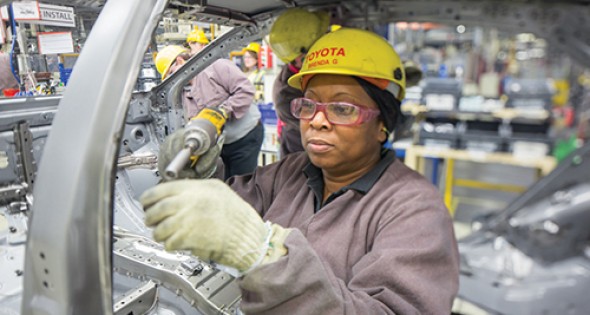
Bringing Together The Internet of Things for Next Gen Cars
19 Sep, 2016
Automotive manufacturers embrace innovative materials and processes on the road to a smarter, more efficient driving experience
By David Hodes
Innovation in manufacturing continues to ramp up in the automotive industry as more data analytics become a bigger part of both car design and the future of how transportation works across the county.
The key area for auto suppliers and the continued evolution of the automobile is cyber security, in part, because of the increasing use of software-over-the-air updates for electronic modules and the increasingly important role of telematics in tomorrow’s vehicles.
According to a study of supplier and supply chain performance by PriceWaterhouse, scalability of new technologies will become increasingly important, driving the need for revolutionary new ideas to be quickly spread and adopted throughout the supply chain. The study found that mass customization and 3-D printing capabilities could continue to shorten development cycle times.
The study concluded that each of these trends, along with its corresponding implications, has the potential to drive supply chain activity for segment participants worldwide.
“To stay ahead of the pace of change and remain relevant in today’s ultra-competitive market, an automotive suppliers’ joint team of supply chain specialists should revisit the organization’s supply chain strategy to determine what it will take to anticipate and effectively respond to changes on the horizon,” the study recommended.
But as these high tech components evolve within the automobile of tomorrow, manufacturers still need to address a core issue that has dogged the industry for years – the search for qualified workforce.
The good news is that the rise of a smarter car is catching the eye of a smarter workforce.
“What I think lot of the younger folks coming out of college and skilled trade areas are realizing is that the automobile is sort of the largest mobile device out there,” Brian Daugherty, chief technology officer for the Motor and Equipment Manufacturers Association (MEMA), says. “It has all of the interesting aspects of a phone app. But then it also has the aspects of system control and mobility and all of those things as well. So there has been a resurgence of interest in automotive because of the high tech nature of vehicles today and the telematics that are in them, and all of the features and applications that are now part of today’s automobiles.”
The fully autonomous vehicle, the ultimate goal of both high tech auto manufacturers and highway infrastructure developers, is a long way away, Daugherty says, because there are just too many real world issues to resolve.
“The world is a random place,” he says. “Humans do a very good job of being put in complex driving situations and figuring out what to do. But it’s very hard for a system to adapt to every potential situation that arises on a road trip.”
A car’s operating system is getting more integrated in an effort to implement this new world concept. Data buses are being upgraded and other things are being tied into telematics. It’s these related telematics devices and sensors that automobile component manufacturers are working on for delivery to the current and future generation of automobile manufacturing.
“It’s going to be a fascinating time because you are going to have all of these features that will essentially help people drive more safely even if they are slightly distracted in certain situations,” Daugherty says.
New ideas boosting new manufacturing
As these new concepts in design and development continue, automobile manufacturing in general has picked up across the country, surging in areas where auto manufacturing has always been strong.
Mississippi for example is in the midst of an historic year when it comes to automobile manufacturing operations, according to Glenn McCullough, executive director of the Mississippi Development Authority. On February 8, Governor Phil Bryant announced a deal with Continental Tire the Americas from Hanover, Germany, to locate most of their tire plant in North America in Hinds County, between Jackson and Vicksburg.
It will be a $1.4 billion capital investment bringing 2,500 new jobs to the state. The area is already home to a Nissan assembly plant in Canton, which has produced more than 3 million cars since it opened in 2003; and the Toyota Motor Manufacturing Mississippi plant in Blue Springs, making the Corolla.
Over a half million vehicles are assembled in the state each year. The state is also home to 70 automotive suppliers and more than 200 automotive related manufacturers.
One of the reasons for the continued growth in automotive manufacturing and assembly operations is Mississippi Works, the workforce program in the state that brings together a network of resources including eight public universities, four research universities, 15 community colleges and job centers throughout the state.
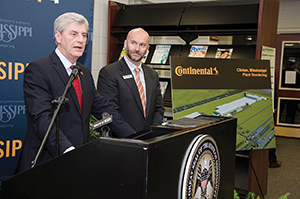
Mississippi Gov. Phil Bryant and Vice President of Commercial Vehicle Tires Continental Tire the Americas Paul Williams, celebrate Continental’s decision facility in Hinds County, Miss., which will create 2,500 new jobs. Courtesy of the Mississippi Development Authority
“The president of Yokohama Tire decided that it was the workforce availability that helped them to get off to one of the best starts in their history,” McCullough says, referring to the new $300 million commercial truck tire facility in West Point that opened in October 2015.
In and around Arlington, Texas, there are three automotive assembly operations in the area. The Toyota truck assembly plant in San Antonio, working on the Tundra; Peterbilt Motors in Denton making semi-trucks; and General Motors, turning out full-sized sport utility vehicles.
While these assembly operations continue to thrive in these cities, there is a drive to get more automotive suppliers to come to the state, according to Bruce Payne, economic development manager for the city of Arlington.
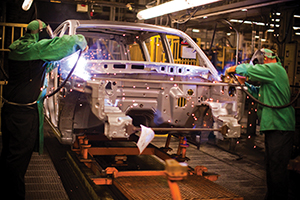
Nissan North America team members have assembled more than 3 million vehicles at their canton, Miss., plant since it first opened in 2003. Courtesy of the Mississippi Development Authority
“We are in a great position where, once a car or truck is built, it can get distributed to the primary market on either coast or in the southern tier quickly,” he says. “But the pieces and parts, the auto supplier manufacturers of these larger vehicles, tend to be closer to the automotive decision makers, like maybe up north for example, closer to Detroit.”
Canada coming on strong
Up north in Canada, Susan Amring, economic development director for the city of Mississauga, Ontario, says that they consider the automotive sector as part of their advanced manufacturing cluster, with a good concentration of automotive suppliers and manufacturers.
There are 90 companies there, many Tier 1 and Tier 2 companies, employing about 5,000, she says. Included are Atlantic Tube and Steel; Commercial Spring and Tool; and Hercules Manufacturing, makers of air brake parts for trucks and trailers.
“We did take a hit in automotive during the recession,” Amring says. “But I think we are starting to see more companies diversify and take on new efficiencies in manufacturing through automation and data exchange and related technologies,” she says. “So I think we are starting to see a sort of reset of the manufacturing in the automotive sector.”
When the automobile industry stalled, the area began to see more development around aerospace and clean tech companies.
“We are now starting to see a convergence and synergies in the clean tech and aerospace and sensors and system integrators from a lot of engineering companies,” she says. “We are really on the cusp of doing some really interesting things in the automotive sector.”

Susan Amring, economic development director for the city of Mississauga, Ontario, says that they consider the automotive sector as part of their advanced manufacturing cluster, with a good concentration of automotive suppliers and manufacturers. Photo courtesy City of Mississauga.
As with many manufacturing-heavy areas of the country, there is also a need to fill the workforce pipeline in Mississauga, where already 43 percent of the automotive workforce has a post-secondary education. “We are talking about manufacturing businesses that have to focus on knowledge and innovation and that internet of things,” Amring says. “All of those things are going to play into this automotive sector development.”
There are five colleges and eight universities that offer automotive related programs in the region. Seneca College, for example, is working now with Siemens in mechatronics training. As part of the agreement, Siemens and Seneca will work towards establishing a framework of co-operation intended to enhance the educational curriculum, training programs and applied research initiatives at Seneca by looking at innovative ways to establish a Siemens certification training program, such as mechatronics and/or smart systems, and by creating and/or expanding internships, apprenticeships and/or co-operative programs with Siemens.
“All of these things have become a real catalyst for this new training and development of people,” Amring says.
A recent report from the Institute for Competitiveness and Prosperity found that the province of Ontario will be creating growth in companies with a great level of specialization and will continue to drive success in the automotive sector. The Institute recommended that Ontario increase the affordability of electric vehicles and the prevalence of charging stations.
To address this concern, Ontario has committed $20 million to constructing 500 electric vehicle charging stations in more than 250 locations. The report found that by responding to the needs of customers and becoming one of the most electric car friendly provinces, Ontario can gain the first-mover advantage and become the leading region in fuel efficient car production.
Sidebar:
Making good use of natural resources
In northern Minnesota, economic developers are targeting original equipment manufacturers (OEM) and auto suppliers for innovative work with environmental testing specific to their climate.
“OEMs began coming up here to do ambient cold start testing,” Paul Nevanen, director of Koochiching Economic Development Authority says. “It’s evolved as the industry has evolved. But that is our focus.”
That sort of development grew quickly as anti-lock brake system (ABS) and stability control systems were developed, attracting companies like Bosch and Kelsey Hayes (now called just Hayes), which are two of the biggest suppliers for ABS.
“We would still like to have some companies come here and manufacture component pieces,” he says. “What we are betting on is the rise of the autonomous vehicle because of the challenges of low temperature on electric vehicles. We are already seeing some manufacturers up here putting in charging stations.”
The area has competitive utility rates, and the entire county is a foreign trade zone, which becomes an important piece of further development in auto manufacturing, Nevanen says. “Motor manufacturers have complex supply chains, and we can help streamline importing in those duty-able items,” he says. There is also a rail-served development site in the county which is served by the Canadian National railroad, along with an international airport. Nevanen thinks they have the pieces to make the area a compelling location.
More details:
– arlingtontx.gov
– businessupnorth.com
– Mississauga.ca
– Mississippi.org
Related Posts
-
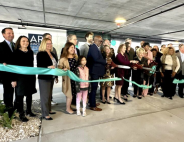
Pinellas County, Florida Celebrates Ribbon Cutting of the ARK Innovation Center Business Incubator
-

Time To “Pivot, Stretch, And Adapt”
-
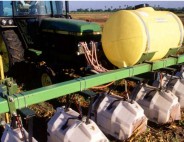
More Efficient Agriculture Techniques are Coming into the Focus
-

Logistics Getting on a Quicker, more Focused Track
-

Opportunity Zones and Post-COVID-19 Economic Recovery
-
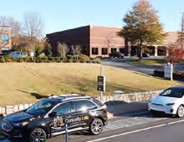
New Ideas Emerge for Both Sustainable and Fossil Fuel Technologies
-
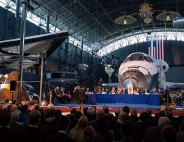
New Goals and New Internet Tech Help Build Base for Advanced Manufacturing
-

Business Services Today Focus on Human Resources, Data Analytics
-
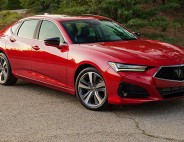
Ready to Shift into High Gear
-

The New Forestry Momentum










